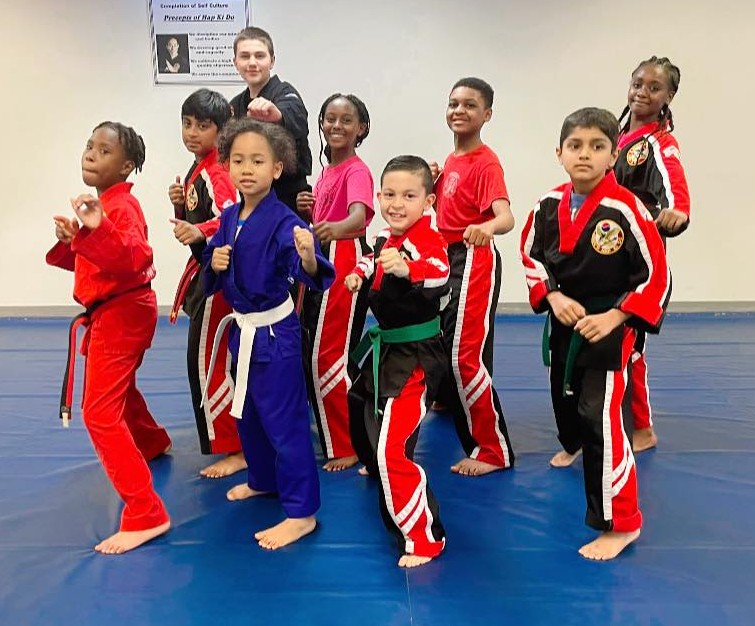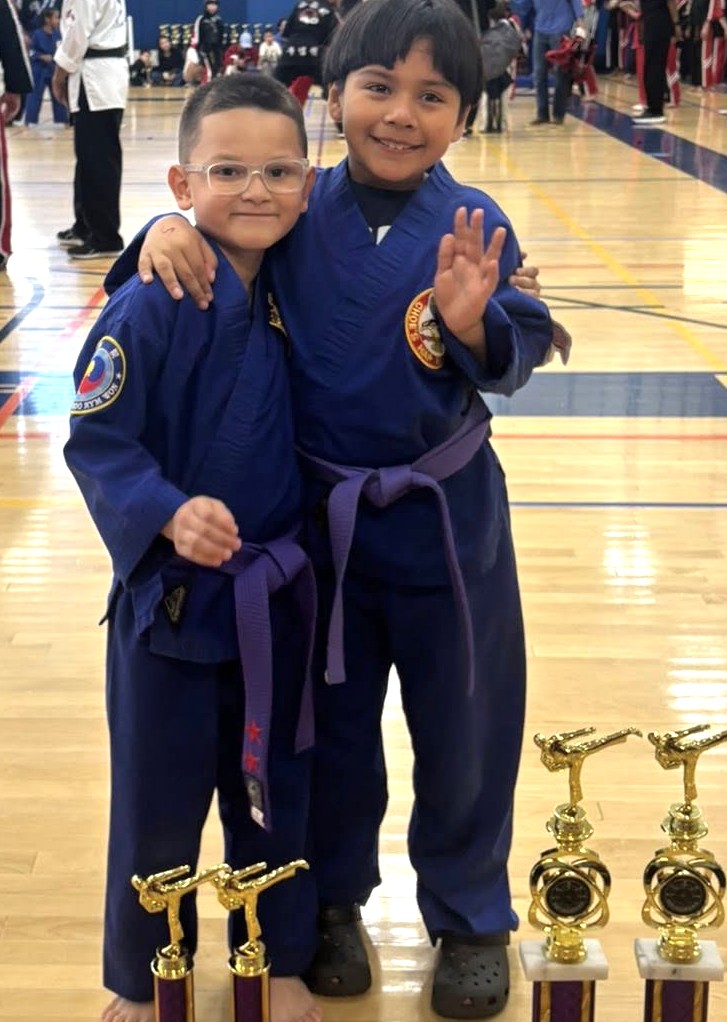
Why Martial Arts for Kids Makes a Difference
Many parents know what it’s like to ask a child to listen… and then watch that request drift right past them. When kids get wiggly, distracted, or overwhelmed, it can be hard to know what will actually help — especially when you’ve already tried reminders, routines, and deep breaths. Many of our Choe’s HapKiDo instructors are parents themselves, and they fully understand the dance of trying to teach kids respect, focus, and good listening on the daily. The good news is that focus and listening aren’t fixed traits; they’re skills kids grow through practice and the right kind of structure.
If you’re looking for a little support in helping your child learn the ropes, Choe’s HapKiDo instructors are right here in your community. Our classes blend movement, routine, and thoughtful guidance to help kids build skills that support them in everyday life — including sharper focus and stronger listening habits. And let’s be honest… sometimes kids magically learn the exact lessons we’ve been trying to teach them, once another adult says it.
That’s the beauty of martial arts for kids — students leave feeling capable, confident, and just a little more respectful than when they walked in. And the best part is that the habits they practice in the dojang tend to show up everywhere else: at home, at school, in clubs, and in all the small moments of their day.
Why Kids Struggle With Focus
Kids are learning so much every day, and sometimes their attention has a hard time keeping up. Their brains are still developing the skills needed to pause, filter out distractions, and follow along — and every child builds those abilities on their own timeline. And with today’s fast-paced world of screens, instant notifications, and quick-hit entertainment, it’s no surprise that many kids are used to things that change quickly and grab their attention for them.
Throw in a full day of school, shifting routines, and environments that keep their senses buzzing, and staying focused can feel like a tall order for even the calmest child. None of this means anything is “wrong”; it simply means they need the right kind of practice.
Clear cues, predictable routines, and movement-based learning all help kids settle in and direct their attention where it needs to go. Martial arts naturally brings all of these elements together, giving children a steady, supportive place to practice focus without pressure or overwhelm.
How Martial Arts for Kids Supports Child Development
1. Self-Regulation: Practicing the Pause
One of the first lessons learned in martial arts for kids is how to pause and wait for a cue — “Fighting stance,” “Attention,” “Bow!” These moments gently teach children to stop, look, and listen before moving. It’s simple, but incredibly effective. Partner drills add another layer by encouraging turn-taking, patience, and working respectfully with someone else. And because it all happens in a fun, structured environment, kids don’t feel pressured. They’re just learning a fun activity, while also understanding how to follow the rhythm of class, listen to the instructor, etc.
How this shows up at home and school:
• Quicker response to directions
• Fewer interruptions
• Smoother transitions between activities
Over time, these small habits change how kids navigate everyday moments. They begin recognizing the value of slowing down before reacting, and that sense of control carries into situations that used to feel challenging.
2. Longer Attention Spans Through Predictable Routines
Martial arts for kids classes follow a familiar rhythm: warm-up ? basic kicking ? target practice with a partner ? rolling ? self-defense ? bow-out at the end. Kids gradually learn what to expect and what’s expected of them, which helps them settle in faster each time they step onto the mat. Because each activity is short, engaging, and purposeful, children practice focusing in small bursts that feel doable rather than overwhelming.
Parents often notice:
• More follow-through with homework
• Easier morning or bedtime routines
• Less drifting during quiet tasks
As kids get used to predictable structure, they start carrying that same confidence into their routines at home. It reduces frustration for everyone and helps children feel more capable during transitions that used to be a struggle.
3. Movement-Based Learning: Listening Through the Body
Some kids learn best while moving — in fact, many do. Martial arts taps into this strength perfectly. A sequence like “kick… freeze… listen” blends motion with stillness, teaching coordination, control, and awareness all at once. Kids begin to understand what focus feels like in their body, which is far more meaningful than simply being told to “pay attention.”
This often leads to:
• Better body control
• Less fidgeting during seated work
• Stronger ability to listen before acting
For a deeper look at how these benefits show up at school, check out the blog Martial Arts Helps Kids in School. When children understand how their movement and attention work together, listening becomes an active skill they can rely on in all kinds of settings.
Changes Parents Notice After Weeks at Martial Arts for Kids
After a few weeks of consistent classes, many parents start spotting small but meaningful changes at home. Kids respond a little faster when their name is called, follow directions with fewer reminders, and show more patience during moments that used to feel tense or rushed. These shifts don’t happen overnight, but they build gradually as children practice focus and self-control in short, manageable doses on the mat.
Families often mention that their child seems more confident too — proud of earning a stripe, mastering a new kick, or showing respect without being reminded. Those wins add up. Even the shy or hesitant kids begin carrying themselves a little taller, knowing they can do things that once felt challenging.
As these habits strengthen, children start applying them in the places that matter most: at home, at school, during routines, or while working with peers. It’s these real-life moments where parents see the biggest difference — the small signs that their child is growing in focus, maturity, and responsibility without losing the fun and joy of being a kid.
Is Martial Arts Right for My Child?
Many parents wonder whether martial arts for kids would be a good fit for their child — especially if their child is energetic, shy, easily distracted, or still learning how to manage big feelings. The truth is, martial arts works well for a wide range of personalities and learning styles. Kids don’t need to be coordinated, confident, or focused before they start; those skills grow naturally once they’re in the right environment.
Instructors guide children step-by-step, giving them clear expectations and lots of positive reinforcement along the way. There’s no rush and no pressure — just steady encouragement and opportunities to practice listening, respect, and self-control at a pace that feels manageable.
Over time, kids begin showing the benefits outside the dojang too. Whether it’s smoother routines, better follow-through, or simply feeling more sure of themselves, martial arts gives children tools they can use in real-life situations. And for many families, that gentle, steady progress is exactly what they’ve been hoping to see.
Before You Try a Class: What to Expect at Martial Arts for Kids
If you’re curious how the first session works, this guide offers a clear and friendly breakdown:
Before Your First Class: What to Expect in a Martial Arts Program
Kids of all personalities — spirited, cautious, chatty, or quiet — are welcomed and supported. Instructors help them feel comfortable, confident, and safe as they explore something new, making the first class an encouraging experience for families.

Ready to See It in Action?
Every child is capable of strengthening their focus and listening skills, and sometimes the biggest breakthroughs happen simply because they’re learning in a different environment. The dojang brings a new set of expectations, a new rhythm, and new voices guiding them — and that shift alone can spark focus in ways that feel fresh and motivating. Martial arts introduces challenge, but in a steady, intentional way that helps kids rise to it without feeling overwhelmed.
Parents often notice that the lessons learned on the mat slip into everyday life: smoother routines, fewer reminders, and a child who stands a little taller because they’re proud of what they’ve accomplished. As kids work through drills, partner activities, and instructor cues, they begin discovering that they can handle more responsibility and attention than they realized. That combination of structure, respect, and challenge is what makes martial arts such a powerful place for growth.
If you’re curious how this environment could support your child, we’d love for you to stop by, meet the instructors, or jump into a free class. Sometimes seeing your child in a new space — with new expectations — is exactly what brings out the focus you’ve been hoping to see.
Join Choe’s HapKiDo and experience how martial arts competition can shape confidence, character, and community for a lifetime.
Check out our locations page to find a school near you and schedule a trial class today! www.TryKarateClasses.com/karate-locations/. Also follow Choe’s HapKiDo on Facebook: https://www.facebook.com/choeshapkidomartialarts !
